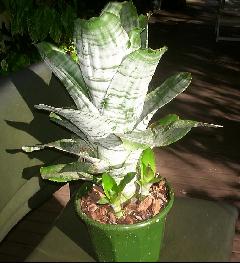
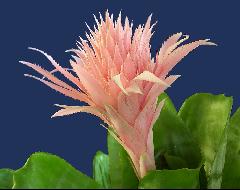
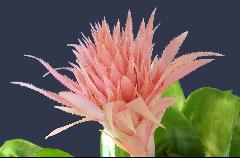
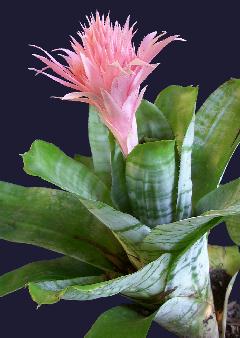
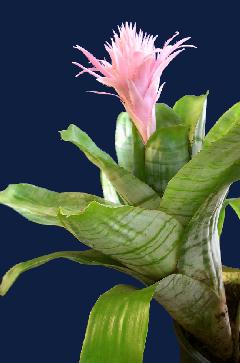
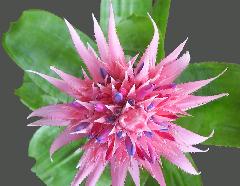
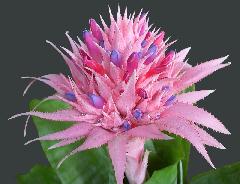
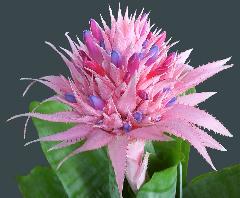
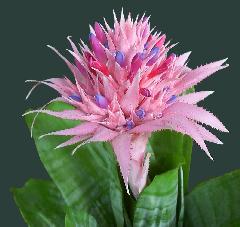
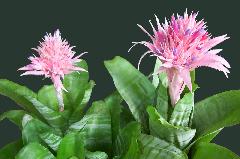
Notes from Chester Skotak
Many years ago there existed an Aechmea fasciata, possibly from Japan that was spineless. This was a common Aechmea 20 years ago and many people had this in their collections and perhaps still do. Since this is a fairly good looking A. fasciata perhaps it also popped out of a meristem program in Japan as a chimera. This A. fasciata, when crossed with any other A. fasciata produced spineless seedlings. This F1 cross is easy to duplicate in a hobby greenhouse and has been by several growers. I believe that all A. fasciata that are spineless originated from what was known as "the Japanese clone", although with bromeliads nothing can be ruled out. Chimeras do appear but the rate of mutation from spiny leaf to smooth leaf must be very rare. It would be easy to understand how a spineless mutation would go unnoticed to the untrained eye.
Today there are many hybrids of aechmeas that are spineless. They present an interesting challenge for the very reason Dutrie hinted at in 1946, that Aechmea fasciata and Aechmea chantinii produce an intermediate cross between the two parents, with the color of chantinii and other characteristics well divided. I can say after making many hundreds of crosses that I have found A. fasciata to be dominate in the hybrid in both shape of the inflorescence, the color and the size. It is in fact very dominate in color when used in crosses. This can be seen when hybrids of others from the Platyaechmea group crossed with A. fasciata usually bloom with some shade of reddish-pink to pink bracts.
Taking the spines off the A. fasciata was the easy part, the hard work lay ahead, of producing spineless A. fasciata in different colors and forms and then making the hybrid between the spineless A. fasciata and the Aechmea chantinii-tessmannii group, not only that, but plants that are culturally perfect, that grow fast, clean, and do not suffer transpiration burn on the leaves. These are the same basic hybrids that Dutrie made a half century earlier but the accessibility of obtaining more types of Aechmea, as well as growing conditions, and general knowledge about bromeliads has changed a lot in the last fifty years.
A. flavo-rosea, A. dealbata, A. caesia, and color forms of A. fasciata such as the "Ivory" or the plant known as "Lavender" were a few of the plants used to change the colors of the A. fasciata. In the Platyaechmea group I use A. chantinii with a stout yellow inflorescence that produces excellent hybrids. Currently we are using yellows and reds and oranges and two albino types of A. tessmanii and A. cucullata. The more hybridizing that I did the more it became apparent that A. fasciata worked best in hybrids when plants were used without trichomes or at best very few trichcomes. Commercially the trichomes are more appealing, but it is a true challenge to produce a bright inflorescence and have the leaves with a silver cast to them. I had ruled out any commercial types of A. fasciata with just too many trichomes and they were not bright enough or fast enough growing. Fewer trichomes give more color. That is the current status of my program with Aechmea. I will follow this article up in ten years time and see where this was all leading. Hopefully I will reach a point of having a spineless Aechmea hybrid, a nice silver color on the leaves, and a large well centered, bright inflorescence, all that I ever hoped for in a hybrid, but will I ever be satisfied?
If Aechmea have the ability to discard their spines, are they coming or going in the evolutionary chain?
Where do the spines go? Here is where I walk out on a limb. All Aechmea that have had the spines hybridized out have an unusual fold somewhere running along the length of the leaf. Is there one or two genes that have been eliminated, or are they simply masked and have been there all the time just relocated somewhere else? Any observant grower or hobbyist of the Bromeliaceae can see this phenomenon by simply holding the leaf up to the light. Sometimes it is a very prominent fold other times it is a faint line. At times the inflorescence of a spineless Aechmea will show spines on the primary or secondary bracts, sometimes very prominent and sometimes hardly at all. This also occurs with pineapples, Ananas comosus, where the crown is spiny. These spiny crowns are discarded and considered only as primitive relics of their ancestors. If a spineless pineapple produces a spiny top, are the genes still there for spines? This fold in the leaf is easily observed on several varieties of spineless Ananas comosus. Perhaps this unusual doubling in the leaf will one day be looked at closer and we can move one step further along in the study of knowledge about our favorite plants, the bromeliads.
One final comment.
Herb Plever points out that his spined 'Morgana' also produces 'pipes' in some plants and this can follow into the offsets. It is possible that 'piping' may well take over from 'quilling' as a favourite Bromeliad discussion topic!